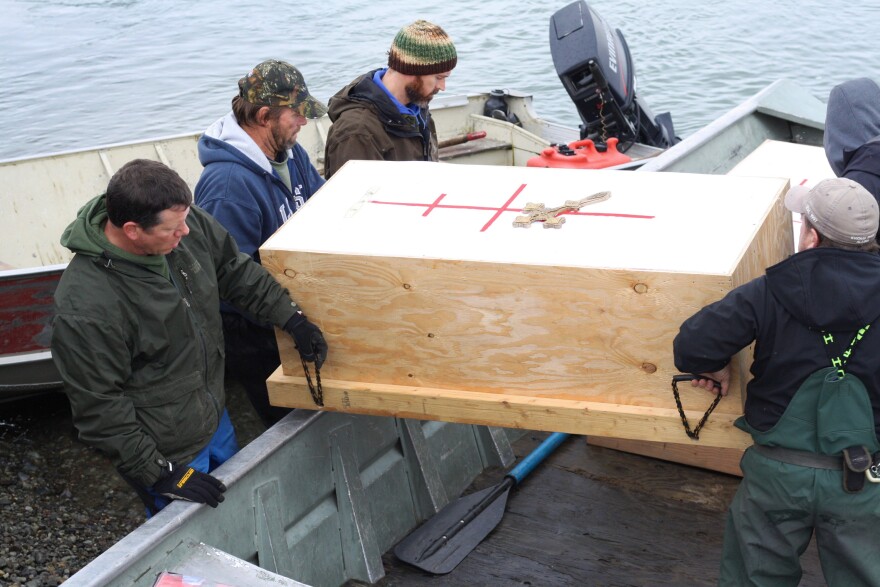Anthropologists once excavated the graves of thousands of Native Americans. Now museums in the U.S. are slowly working to return those remains and funerary objects to tribes.
A village in southwest Alaska recently reburied 24 of their ancestors who had been excavated by a Smithsonian anthropologist in 1931.
About half of the village of Igiugig crowded into the Russian Orthodox Church in the center of town on a drizzly fall day. In the center of the nave sat three handmade, wooden coffins that held the bones from the now-abandoned settlement of Kaskanak.
The remains were unearthed by Aleš Hrdlička, who was the head of the anthropology department in what is now the Smithsonian's National Museum of Natural History. The question of how people originally came to North America and from where drove Hrdlička to dig up the bones of Native Americans all around the United States. Historians estimate that he took thousands to Washington, D.C., for research.
After more than eight decades in the museum's collection, Igiugig's ancestors finally returned home for reburial.
The community of Igiugig is majority Yupik, a people group native to Alaska.
Annie Wilson, an elder in the village, attended the funeral service and explained that Hrdlička's excavation was fundamentally objectionable in Yupik culture.
"We were always taught you don't dig up old bones of anything or anybody. That's their resting place until the good Lord comes someday," said Wilson.

It took about two years after the village of Igiugig requested these remains for the repatriation to be approved. First the Smithsonian went through a process to verify that the people from Kaskanak were culturally affiliated with the people of Igiugig.
Bill Billeck, director of the Smithsonian's Repatriation Office, said the institution examined the remains as well as original documents, including Hrdlička's diaries. The museum also learned about the oral history of the Igiugig, which says that the ancestors of the current village had abandoned Kaskanak generations ago.
The institution also leaned heavily on the work of AlexAnna Salmon, an Igiugig local who has extensively researched the area's history.
"This was a collaborative effort between the Smithsonian and our village, but it was really us telling them that these are ours," Salmon said. "This is who we are. It's not anthropology coming from the other direction, telling you who you are and where you came from."
The Smithsonian is ostensibly an institution that collects artifacts, but returning pieces of its collection has become part of its duty in recent decades. The National Museum of the American Indian Act and the Native American Graves Protection and Repatriation Act require museums to make these materials available to federally recognized tribes. When those laws were passed in 1989 and 1990, museums around the United States held the remains of roughly 200,000 Native American individuals. The National Museum of Natural History held about 19,000 of those.
This year, the NMNH has returned the remains of 31 people, including the 24 from Kaskanak.
When the bones left the church after the funeral service, they had one more stretch of their journey. The coffins were loaded into a skiff, and the rest of the village piled into a few other boats.
This time, the bones were accompanied by the current director of the Smithsonian NMNH, Kirk Johnson. He reflected on the importance of his museum's repatriation work to tribes nationwide.
"Some of their grandparents or their more recent relatives are actually in museums as collection items, which just doesn't make much sense from a human point of view," Johnson said. "There is something that is very unfair that was done here, and we want the tribes, groups or corporations to be able to petition to have their bodies or their funerary objects returned to them."
At the site, a hole was already dug on the hillside overlooking the Kvichak River. The priest prayed as the coffins were lowered. Then he sprinkled dirt into the graves with a long-handled shovel. He passed the shovel to Johnson. Alongside Johnson, the children of Igiugig tossed in dirt by the handful. The rest of the village pitched in, and soon only three white crosses and a fresh pile of soil marked the grave.
After the bones were laid to rest, the village performed a yuraq, a traditional Yupik dance. Facing east with dance fans held high, voices raised and drums beating loudly, they blessed their ancestors and reclaimed two dozen members of their community.
Copyright 2017 KDLG 670AM







